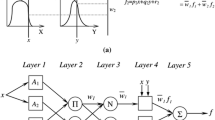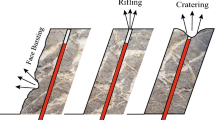Abstract
One of the threatening safety problems in mines is flyrock distance range through blasting operation. Inaccurate evaluation of flyrock can cause fatal and nonfatal accidents. The presented results in this paper verify efficiency of artificial neural network in prediction of flyrock considering all influencing parameters such as: hole diameter, height, subdrilling, number of holes, spacing, burden, ANFO amount, dynamite weight, stemming, powder factor, specific drilling, and delay time. In this research, optimum structure of network was determined by studying different transfer functions and number of the neurons using a programming code. In this case, optimum structure configuration is logsig transfer functions for the two hidden layers and tansig or logsig one for output, and there are eight neurons in each hidden layers. By calculating strength of relationship between flyrock and all influencing parameters using cosine amplitude method (CAM), the powder factor is defined as most effective parameter on the flyrock.







Similar content being viewed by others
References
Rezaei M, Monjezi M, Yazdian Varjani A (2011) Development of a fuzzy model to predict flyrock in surface mining. Saf Sci 49(2):298–305
Sari M, Selcuk AS, Karpuz C, Duzgun HSB (2009) Stochastic modeling of accident risks associated with an underground coal mine in Turkey. Saf Sci 47(1):78–87
Kecojevic V, Radomsky M (2005) Flyrock phenomena and area security in blasting-related accidents. Saf Sci 43(9):739–750
Verakis H, Lobb T (2003) An analysis of surface coal mine blasting accidents. In: Preprint for SME 2003 annual meeting, Littleton, Colorado, USA
NIOSH (2000) Worker health chartbook. US Department of Health and Human Services, Atlanta
Khandelwal M, Singh T (2007) Evaluation of blast-induced ground vibration predictors. Soil Dyn Earthq Eng 27(2):116–125
Vishal V, Pradhan S, Singh T (2010) Instability assessment of mine slope—a finite element approach. Int J Earth Sci Eng 3(6):11–23
Singh T, Pradhan S, Vishal V (2013) Stability of slopes in a fire-prone mine in Jharia Coalfield, India. Arab J Geosci 6(2):419–427
Kainthola A, Verma D, Gupte S, Singh T (2011) A coal mine dump stability analysis—a case study. Geomaterials 1(01):1
Verma D, Thareja R, Kainthola A, Singh T (2011) Evaluation of open pit mine slope stability analysis. Int J Earth Sci Eng 4(4):590–600
Yari M, Monjezi M, Bagherpour R, Sayadi A (2015) Blasting operation management using mathematical methods. In: Lollino G, Manconi A, Clague J, Shan W, Chiarle M (eds) Engineering geology for society and territory, vol 1. Springer, Switzerland, pp 483–493
Yari M, Bagherpour R, Jamali S (2015) Development of an evaluation system for blasting patterns to provide efficient production. J Intell Manuf 1–10. doi:10.1007/s10845-015-1036-6
Yari M, Monjezi M, Bagherpour R (2013) Selecting the most suitable blasting pattern using AHP-TOPSIS method: sungun copper mine. J Min Sci 49(6):967–975
Yari M, Monjezi M, Bagherpour R (2014) A novel investigation in blasting operation management using decision making methods. Rudarsko-Geolosko-Naftni Zbornik 29:69–79
Yari M, Monjezi M, Bagherpour R, Jamali S (2014) Developing a mathematical assessment model for blasting patterns management: sungun copper mine. J Cent South Univ 21(11):4344–4351
Verakis H, Lobb T (1999) Blasting accidents in surface mines, a two decade summary. In: Proceedings of the annual conference on explosives and blasting technique, 2001. ISEE, pp 145–152
Siskind DE, Kopp JW (1995) Blasting accidents in mines: a 16-year summary. In: Proceedings of the twenty-first annual conference on explosives and blasting technique, vol 2. International Society of Explosives Engineers, Cleveland, OH
Rehak T, Bajpayee T, Mowrey G, Ingram D (2001) Flyrock issues in blasting. In: Proceedings of the annual conference on explosives and blasting technique, 2001. ISEE, pp 165–176
Bajpayee T, Rehak T, Mowrey G, Ingram D (2004) Blasting injuries in surface mining with emphasis on flyrock and blast area security. J Saf Res 35(1):47–57
Bajpayee T, Verakis H, Lobb T (1999) An analysis and prevention of flyrock accidents in surface blasting operations. In: Proceedings of the annual conference on explosives and blasting technique, 2004. ISEE, pp 401–410
IME (1997) Glossary of commercial explosives industry terms. Institute of Makers of Explosives, Washington
Langefors U, Kihlström B, Kenkyūjo KS (1967) The modern technique of rock blasting. Almqvist & Wiksell, Stockholm
Holmeberg R, Persson G (1976) The effect of stemming on the distance of throw of flyrock in connection with hole diameters. Report DS 1, Swedish Detonic Research Foundation
Roth J (1979) A model for the determination of flyrock range as a function of shot conditions. US Bureau of Mines contract J0387242. Management Science Associates, Los Altos
Persson P-A, Holmberg R, Lee J (1993) Rock blasting and explosives engineering. CRC Press, Boca Raton
Lundborg N (1974) The hazards of flyrock in rock blasting. Reports DS 12, Swedish Detonic Research Foundation
Lundborg N (1981) Risk for flyrock when blasting. BFR report R 29, Swedish Council for Building Research, Stockholm
Bajpayee T, Rehak T, Mowrey G, Ingram D (1999) A summary of fatal accidents due to flyrock and lack of blast area security in surface mining, 1989 to 1999. In: Proceedings of the annual conference on explosives and blasting technique, 2002. ISEE, pp 105–118
Fletcher L, D’Andrea D (1986) Control of flyrock in blasting. In: Proceedings of 12th conference on explosives and blasting technique, Atlanta, Georgia, pp 167–177
Ladegaard-Pedersen A, Persson A (1973) Flyrock in blasting II, experimental investigation. Report DS 13, Swedish Detonic Research Foundation, Stockholm
Monjezi M, Dehghani H, Singh T, Sayadi A, Gholinejad A (2012) Application of TOPSIS method for selecting the most appropriate blast design. Arab J Geosci 5(1):95–101
Shea C, Clark D (1998) Avoiding tragedy: lessons to be learned from a flyrock fatality. Coal Age 103(2):51–54
Kalogirou SA (2000) Applications of artificial neural-networks for energy systems. Appl Energy 67(1):17–35
Khandelwal M, Roy M, Singh P (2004) Application of artificial neural network in mining industry. Indian Min Eng J 43(7):19–23
Meulenkamp F, Grima MA (1999) Application of neural networks for the prediction of the unconfined compressive strength (UCS) from Equotip hardness. Int J Rock Mech Min Sci 36(1):29–39
Yang Y, Zhang Q (1997) Analysis for the results of point load testing with artificial neural network. In: Proceedings of the computer methods and advances in geomechanics. IACMAG, China, pp 607–612
Cai J, Zhao J (1997) Use of neural networks in rock tunneling. In: Proceedings of the computer methods and advances in geomechanics. IACMAG, China, pp 613–618
Khandelwal M, Singh T (2005) Prediction of blast induced air overpressure in opencast mine. Noise Vib Worldw 36(2):7–16
Singh V, Singh D, Singh T (2001) Prediction of strength properties of some schistose rocks from petrographic properties using artificial neural networks. Int J Rock Mech Min Sci 38(2):269–284
Monjezi M, Dehghani H (2008) Evaluation of effect of blasting pattern parameters on back break using neural networks. Int J Rock Mech Min Sci 45(8):1446–1453
Parker DB (1985) Learning logic. File 1, Office of Technology Licensing. Stanford University, USA
Reed RD, Marks RJ (1998) Neural smithing: supervised learning in feedforward artificial neural networks. MIT Press, Cambridge
Neaupane KM, Achet SH (2004) Use of backpropagation neural network for landslide monitoring: a case study in the higher Himalaya. Eng Geol 74(3):213–226
Monjezi M, Bahrami A, Yazdian Varjani A (2010) Simultaneous prediction of fragmentation and flyrock in blasting operation using artificial neural networks. Int J Rock Mech Min Sci 47(3):476–480
Singh R, Vishal V, Singh T, Ranjith P (2013) A comparative study of generalized regression neural network approach and adaptive neuro-fuzzy inference systems for prediction of unconfined compressive strength of rocks. Neural Comput Appl 23(2):499–506
Singh R, Vishal V, Singh T (2012) Soft computing method for assessment of compressional wave velocity. Sci Iran 19(4):1018–1024
McCulloch WS, Pitts W (1943) A logical calculus of the ideas immanent in nervous activity. Bull Math Biophys 5(4):115–133
Rosenblatt F (1958) The perceptron: a probabilistic model for information storage and organization in the brain. Psychol Rev 65(6):386
Simpson PK (1990) Artificial neural system—foundation, paradigm, application and implementations. Pergamon Press, New York
Haykin S (2007) Neural networks: a comprehensive foundation, 3rd edn. Macmillan College Publication, New Jersey
Singh R, Kainthola A, Singh T (2012) Estimation of elastic constant of rocks using an ANFIS approach. Appl Soft Comput 12(1):40–45
Rumelhart DE, McClelland JL, Group PR (1986) Parallel distributed processing: explorations in the microstructure of cognition, vols 1 and 2. MIT Press, Cambridge
Kapageridis I (2002) Artificial neural network technology in mining and environmental applications. In: 11th international symposium on mine planning and equipment selection (MPES 2002). VŠB-Technical University of Ostrava, Prague
Sazid M, Singh T (2013) Two-dimensional dynamic finite element simulation of rock blasting. Arab J Geosci 6(10):3703–3708
Khandelwal M, Singh T (2006) Prediction of blast induced ground vibrations and frequency in opencast mine: a neural network approach. J Sound Vib 289(4):711–725
Singh A, Panda S, Chakraborty D, Pal S (2006) Predicting drill wear using an artificial neural network. Int J Adv Manuf Technol 28(5–6):456–462
Rumelhart DE, Hinton GE, Williams RJ (1988) Learning representations by back-propagating errors. MIT Press, Cambridge
Sungun Copper Mine (2014). http://en.wikipedia.org/wiki/File:Iran_location_map.svg
Richards A, Moore A (2004) Flyrock control-by chance or design. In: Proceedings of the annual conference on explosives and blasting technique, ISEE 1999, pp 335–348
Jong Y-H, Lee C-I (2004) Influence of geological conditions on the powder factor for tunnel blasting. Int J Rock Mech Min Sci 41:533–538
Author information
Authors and Affiliations
Corresponding author
Rights and permissions
About this article
Cite this article
Yari, M., Bagherpour, R., Jamali, S. et al. Development of a novel flyrock distance prediction model using BPNN for providing blasting operation safety. Neural Comput & Applic 27, 699–706 (2016). https://doi.org/10.1007/s00521-015-1889-9
Received:
Accepted:
Published:
Issue Date:
DOI: https://doi.org/10.1007/s00521-015-1889-9




